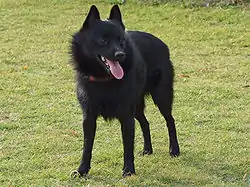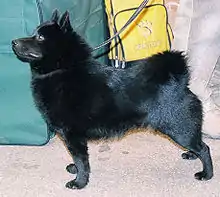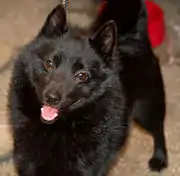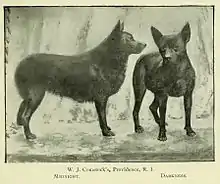Schipperke
A Schipperke (/ˈskɪpərkiː/; Dutch: [ˈsxɪpərkə]) is a small breed of dog that originated since the 1600's in Belgium.[2] There has been a long informal debate over whether this type of dog is a spitz or miniature sheepdog. In their home country of Belgium they are considered a small shepherd.[3] DNA research has shown that Schipperkes have a close relationship to the Spitz family of dog breeds.[4]
| Schipperke | |||||||||||||||||||||||||||
|---|---|---|---|---|---|---|---|---|---|---|---|---|---|---|---|---|---|---|---|---|---|---|---|---|---|---|---|
 Schipperke ready for action. | |||||||||||||||||||||||||||
| Common nicknames | Spitzke (until 1888) Spits (until 1888) Spitske (until 1888), Little Black Devil (Belgium), Little Captain (Flemish) | ||||||||||||||||||||||||||
| Origin | Belgium | ||||||||||||||||||||||||||
| |||||||||||||||||||||||||||
| |||||||||||||||||||||||||||
| Notes | American Kennel Club, Schipperke breed info, Official AKC Standard of the Schipperke General Appearance | ||||||||||||||||||||||||||
| Dog (domestic dog) | |||||||||||||||||||||||||||
Description

Physical
The Schipperke is a small, sturdy, usually black dog in the Spitz family.[5] Their pointed ears are erect atop the head. Schipperkes are double coated with a soft, fluffy undercoat that is covered by a somewhat harsher-feeling and longer outer coat. One of the breed characteristics is a long ruff that surrounds the neck and then a strip trails down towards the rear of the dog. They also have longer fur on their hind legs called culottes. The breed is usually black, but sometimes blonde or cream colored (some blondes have a silkier coat), very rarely they can have a liver-red coloration. And the coat is shiny. Dogs of this breed usually weigh 3–9 kg (6.6–19.8 lb).
In Canada and the United States, the tail is usually docked (cut off) the day after birth. In countries that have bans on docking, adult Schipperkes often have Spitz-like and often up-curled, spiraled, long-haired tails can which occasionally vary in type. There have been animal cruelty complaints about the practice of docking. This includes the fact that dogs often express emotions and various behavioral modes with their tails. It is not known how this loss of behavioral and emotional expression affects the animal.
Owners of undocked adult Schipperke have often commented that the spiral curled, long-haired tails of the dog are quite attractive and that the practice of removing them makes the breed less appealing to the eye. Puppies are born with tails in different lengths. However, they are among those dogs with the rare natural bobtail C189G mutation.[4]
Personality and behavior
Schipperkes are naturally curious and high-energy dogs and require much exercise. They are sometimes very active, running very fast and then breaking into quick, agile criss-cross patterns. However the same Schipperke can also rest for hours on end. So they are not constantly active, in contrast to the Jack Russell terrier. The Schipperke is Known for a stubborn, mischievous, and headstrong temperament, it also chases small animals. The Schipperke is sometimes referred to as the "little black fox", or the "little black devil". In Australia they are sometimes called the "Tasmanian black devil." Schipperkes are very smart and independent; and sometimes debate listening to owners, instead choosing to do whatever benefits them the most, and are not necessarily the proper dog for a first-time dog owner. Schipperkes require training and a secure, fenced-in space in which to run. They must be leash-trained or they will often pull the leash as if they were a sled dog with no regard for the owner.This is easily correctable using training methods from a reliable source. Schipperkes are also escape prone and very fast so they require a leash or a fence at all times.
Schipperkes are notorious around horses and should only be kept leashed when near them. Even if a horse is in full trot, a Schipperke may run at it and then and dart back and forth between its hoofs, narrowly avoiding being crushed and barking furiously all the while. The dogs are so agile and fast that they rarely get hurt, but the horse and rider, not to mention the owner can be surprised by this. Not all Schipperkes do this. Some are calm around large hoofed animals and may only give a couple of curious sniffs before turning away. Good training can also help.
Schipperkes are formidable barkers and can be aggressive with other dogs if they are strangers. Yet they get along well with dogs whom they already know, especially dogs from their own household. They are known for challenging dogs they are unfamiliar with and can sometimes get into fights. Schipperkes are fearless and will, without reservation, go after a dog that is much larger than themselves. Sometimes this results in the Schipperke getting bitten, even badly so. Wounds and bites can be hidden by fur and can so go undetected until a dangerous infection sets in. A trip to the vet after a dogfight is therefore always required in order to find and stitch up any wounds and especially to provide antibiotics. The vet will often shave the fur off of a suspected area in order to find the real extent of bite holes or gashes that might need treatment. This is a good reason why keeping a Schipperke leased and fenced at all times is advisable. Schipperkes are very good with children and were once guard dogs so they make good family protectors. They have no fear of intruders, despite their small size and will bark aggressively, sounding an alarm. They can also harass an intruder by dancing in fast circles around their legs while barking. But they almost never bite humans.And when strangers are outside Schipperkes will bark to alert their owners. Schipperkes are often the first to alert the household because their hearing is better than that of humans. Consequently they make good guard dogs.
Schipperkes are somewhat aloof but will readily accept affection from others. Despite being less affectionate themselves, they will sleep with their head in an owners lap, if there is a close relationship. They have also been known to rest their head in an owner's hand. This is more likely to happen when someone spends a lot of time with the dog. Schipperkes will also sleep in an owners bed although they rarely spend a whole night in one location, so they will usually be gone halfway through the night. If there is more than one Schipperke in a household they will often keep watch, lay and sleep together.
Schipperkes are very aware of who is the dominant human in the home and they will display exclusive submissive affection towards them. Typically they will lie on their backs with their bellies exposed, their ears folded back, and if petted or stroked, will lick the dominant humans hand slowly. They will only do this for one person in the house and are keen observers of who is the strongest sounding human in the "pack". Schipperkes will however, become very excited and demonstrative towards anyone who grabs a leash as they know this means they will be going outside. They can sometimes have similar responses when someone is preparing food for them in their bowl. As aloof as they can be, they can become very excited and expressive in these situations.
Schipperkes who live alone in a back yard can become problem barkers. One way to solve this is to get another Schipperke, so the first one will have a companion. This will tend to quiet them down. They do well in groups up to four and since they know each other, they will get along and even rest close to each other. If encouraged by the owner making a howling sound, they will howl together, but not very often on their own initiative and not for very long.
The Schipperke has been described as a large dog in a small body. It has the instincts of a guard dog – protective, devoted, and courageous At the time the breed was developed, dogs had to be useful to justify their existence. Just as a sheepdog was the guardian of herds and farm property, the Schipperke was the guardian of the household. In common with all guarding breeds, Schipperkes possess an inordinate sense of responsibility towards the home and everything in it and have a loyalty for those to whom they are devoted. Although the Schipperke is a small dog, its sharp bark will make enough noise to scare away any burglars or unwelcome strangers. The Schipperke is an inquisitive breed – a trait which creates the perfect watchdog. Nothing in the home escapes close inspection. The breed is interested, alert and active with a capacity for fun and mischief. Many have also performed well in agility and obedience.[6]
In 1882, a Belgian writer described the Schipperke temperament thus: ‘A little, black devil, but minus the cloven hoof and the tail, such is the Boatman’s dog. A very demon for rats, mice, moles and anything that moves. An indefatigable watchdog, he rests neither day nor night always on foot never weary of inspecting the house from cellar to garret and as soon as he observes anything amiss he warns his master by his piercing barks. He knows the ways of the family, mixes himself into everything and ends up by thinking that he is the one who directs the household. His fidelity to his master is unalterable; his gentleness with children is equal to any test, but let a stranger beware if he lays a hand on any object or person; the Schipperke has teeth and can use them. A good stable dog, he is a great friend with horses and an excellent Horseman’.[7]
Health

The Schipperke has no particular health problems. The UK Kennel Club survey puts the median lifespan of the breed at 13 years old, with about 20% living to 15 years or more. Of the 36 deceased dogs in the survey, the oldest dog was 17+1⁄2 years old.[8] There is a known case where a Schipperke lived to be 18 to 19 years old. Nonetheless, inactivity, lack of exercise and over-feeding are very harmful, and can lead to joint and skeletal problems and tooth, heart, lung or digestive conditions. Schipperke's primary orthopedic problem tends to be luxating patella and Legg-Perthes syndrome. Some Schipperkes have demonstrated tendencies to epilepsy, although there are no tests: these seem to be related to genetic transmission.[9]
The one caveat to the Schipperke's good health is MPS IIIB, a genetic mutation that occurs in at most 15% of the total breed population. It only occurs in Schipperkes. The University of Pennsylvania School of Veterinary Medicine has developed a test for the disease and began accepting samples in April 2003.[10] Clinical signs appear between two and four years of age, and there are no known cures or treatments. The disease affects balance, negotiation of obstacles (such as stairs), and is similar to such lysosomal storage diseases in humans as Tay–Sachs disease and Gaucher disease.[11] The Schipperke is also prone to some other physical problems as reported by the Orthopedic Foundation for Animals.[12]
DNA research has shown that Schipperkes have a rising rate of inbreeding in their population.[13]
Grooming

The Schipperke does not need expensive or excessive grooming. This breed is a moderate shedder, however; a brush that can reach the undercoat is best. Regular weekly brushing is usually enough to keep the coat in good condition. There is no need for cutting or trimming and the ruff (hair around the neck) fluffs up naturally.
Schipperkes can "blow" their coats up to several times a year, and usually females more frequently than males. When this happens, they lose their undercoat. Owners typically find warm baths helpful during this time to remove the undercoat, rather than getting fur all over the home. A blown undercoat can last several days or weeks, and can take up to 2–3 months to grow back.
History

The earlier common references to Schipperkes suggest that they may have originated in the 1600's in Belgium.[14] Schipperkes were first recognized as a formal breed in the 1880s, their standard being written in 1889. Much of what is known of their origins and early history comes from Chasse et Pêche (French for "Hunting and Fishing") magazine, articles from which were translated into English and published by the English magazine The Stockkeeper.
The breed name "Schipperke" means "little boatman" or "little captain" in the Flemish language.[15] However while they were occasionally seen on barges it was not their original or primary function, and in the areas of Leuven and Brussels "scheper" (which sounds similar to "schipper"; a German Shepherd dog is known in Dutch as a "Duitse scheper") was the word for shepherd, making the name translate as "little shepherd".[3]
Before the name "Schipperke" was officially taken, the breed was also known colloquially as "Spits" or "Spitzke", a name commonly used to describe a small dog with pointed ears. They were also occasionally called "Moorke", meaning "little black animal". Schipperkes are widely referred to in the United States, albeit erroneously, as "Belgian canal barge dogs" or "Belgian ship dogs." Apparently, however, their history dates to a seventeenth-century black shepherd dog commonly called the Leuvenaar, a 40-pound dog often found in the Louvain region of Belgium and employed to guard flocks and transport. These dogs are apparently the foundational breed for both the modern, and smaller, Schipperke and the modern, and larger, Black Belgian Shepherd Dog, also known as the Groenendael.[16]
In World War II, the Belgian Resistance used the dogs to run messages between various resistance hideouts and cells, to which occupying Nazi forces were none the wiser.[17]
Genetic genealogy/DNA research
DNA laboratory studies have shown that the Schipperke is more closely related to the Pomeranian dog than the Belgian sheepdog and is very closely tied to Spitz type breeds. DNA studies also show a steady increase of inbreeding in Schipperkes.[18]
In popular culture
A Schipperke is intermittently featured in the tiger-centric movie Two Brothers (2004)[19] and also appears in Daphne Du Maurier's short story "A Borderline Case."
See also
- Dogs portal
- List of dog breeds
- Spitz
- Shepherd
- Groenendael, also known as the Black Belgian Shepherd.
- Belgian Laekenois
- Belgian Tervuren
References
- The Institute of Canine Biology website, Schipperke Shipperke closeer to the Pomemeranian and very close to the Spitz family Evidence inbreeding is rising.
- Alexandra Anastasio (January 31 2017) American Kennel Club official website "What Was the Schipperke Bred To Do"
- Dr. Robert Pollet. "The Schipperke … what's in a name?". schipperke.be. Archived from the original on October 9, 2014. Retrieved 2019-03-22.
- The Institute of Canine Biology website, Schipperke Shipperke closeer to the Pomemeranian and very close to the Spitz family Evidence inbreeding is rising.
- The Institute of Canine Biology website, Schipperke Shipperke closeer to the Pomemeranian and very close to the Spitz family Evidence inbreeding is rising.
- https://www.schipperkeclub.co.uk/wp-content/uploads/2018/03/Revised2018_Schip_Club_leaflet.pdf
- https://www.schipperkeclub.co.uk/wp-content/uploads/2018/03/Revised2018_Schip_Club_leaflet.pdf
- "Individual Breed Results for Purebred Dog Health Survey".
- Skipperke Club, p. 2
- University of Pennsylvania, School of Veterinary Medicine, Mucopolysaccharidosis IIB (MPS IIIB), 2008
- University of Pennsylvania, School of Veterinary Medicine, "New DNA-based Test for Inherited Diseases in Schipperkes." The Bellwether 56:Sept. 2003, pp 7, 9.
- Schipperke health survey. Orthopedic Foundation For Animals. offa.org
- The Institute of Canine Biology website, Schipperke Shipperke closeer to the Pomemeranian and very close to the Spitz family Evidence inbreeding is rising.
- Alexandra Anastasio (January 31 2017) American Kennel Club official website "What Was the Schipperke Bred To Do"
- American Kennel Club official website, Schipperke, History section Schipperke: Confident/Alert/Curious
- American Kennel Club, History of the Skipperke, AKC, 2013.
- "meet the...Schipperke". Continental Kennel Club. Retrieved 2019-03-22.
- The Institute of Canine Biology website, Schipperke Shipperke closeer to the Pomemeranian and very close to the Spitz family Evidence inbreeding is rising.
- Coile, Caroline (December 21, 2015). "Get to Know the Schipperke: The Little Captain!". Dogster. Retrieved 2019-03-22.
External links
| Wikimedia Commons has media related to Schipperke. |
- American Kennel Club, Schipperke breed info
- Official Standard of the Schipperke General Appearance
- Schipperke at Curlie